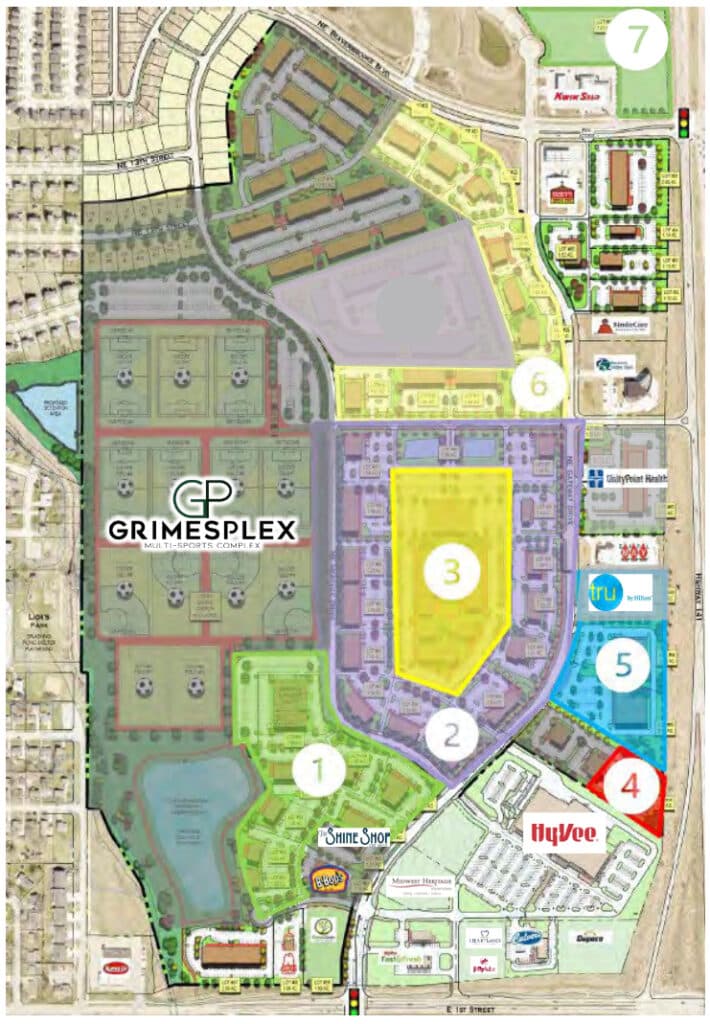Grimes’ Hope District continues to evolve

Michael Crumb Sep 18, 2024 | 6:00 am
6 min read time
1,431 wordsAll Latest News, Real Estate and DevelopmentThe groundbreaking of a new Tru by Hilton hotel this week marked the next phase of development of Grimes’ Hope District, a multiuse development that includes the GrimesPlex sports facility.

The hotel is only the second in Grimes and is needed to meet the increasing demand in the city of nearly 17,000 people, city leaders and developers said.
The 200-acre Hope District extends from north of West First Street to Northeast Beaverbrooke Boulevard, and west of Iowa Highway 141. The district has attracted 2.1 million visitors over the past year, including to the newly developed commercial areas. Also included in that number are 436,000 visits to the GrimesPlex from 114,000 unique visitors, city officials said.
Alex Pfaltzgraff, director of development services for the city of Grimes, said the GrimesPlex occupies 50 acres. About 100 acres remain available for development.
Some of that will include luxury housing on the north end of the district, including 320 apartments and townhomes in a gated-style community, he said.
There is also a 6- to 7-acre pond, and 30 acres that will be developed as a town center concept with retail, restaurants, entertainment, medical, office and green space.
There is also space for retail and other commercial growth surrounding the town center space, including the hotel, where site work is underway.
Pfaltzgraff said the city is working with the developer, Hope Development & Realty, to get the town center development and the surrounding parcels right.
“They’re interested in spending some time to really build a plan so that it’s done right,” he said. “They want to spend time to get the right mix of tenants, the right mix of uses and buildings and create an amenity of sorts, a lifestyle.”
Katie Lord, Grimes director of economic development, said the Hope District will offer a greater appeal to more people than just those who visit the GrimesPlex.
“The fields are a large attraction, but whatever is developed in the Hope District, it has to matter to people who live here and frequent this area on a day-to-day basis,” she said. “From what we hear, the retail and restaurants are what we hear from residents the most.”
Lord said the Grimes City Council has also identified an entertainment venue as a strategic priority.
“What that looks like, we’re not sure yet,” she said. “Time will tell, and the market will identify what can be supported here, but that’s a big focus for development at the Hope District as well.”
Pfaltzgraff said Grimes has been built on the foundation of young families, so whatever entertainment venue is built will be a place that families can go and do something different.
“We’re currently lacking in that today, and we have to export to another community to engage in those types of activities,” he said. “In my mind, it’s youth-family oriented.
“I don’t view it as a 3,000-seat concert venue.”
Lord said she would like to see something unique and different, and something that is maybe a first in Iowa.
“I would love to see something that supports community engagement for all four seasons,” she said. “What that looks like, none of us know, but we’re excited to talk with developers about what the vision could be.”
The development will also need to meet the demands of the fast-growing city.
Grimes’ current population is just under 17,000, more than double than what it was in 2010, when about 8,000 people called it home.
Pfaltzgraff said that kind of growth provides opportunities for future development in the city.
“Rooftops drive everything,” he said. “You have to get that critical mass of people living in a community for things like retail to be warranted.”
According to Pfaltzgraff, retail generally won’t look at a city until it reaches a population of 15,000 to 20,000.
“I think it’s a great opportunity for our community as we continue to grow in a strategic and meaningful way,” he said.
All the streets, sewer and water are in place and parcels are ready for construction. Although lots have been platted, there is flexibility built in to accommodate the needs of tenants, Pfaltzgraff said.

Next steps
According to Lord, some projects are already under construction or breaking ground with construction being visible on many during the first quarter of 2025. One example is a Chipotle restaurant. Another is the hotel, which is only the second hotel in Grimes. The other is the 70-room AmericInn near the intersection of Highway 141 and First Street, or Iowa Highway 44.
The new Tru by Hilton hotel is more than 53,000 square feet, with 116 rooms, a pool, fitness center and a food pantry.
Pfaltzgraff said he anticipates another hotel will follow suit and go up in the area.
He said it’s tough to say when the Hope District will be fully built out. He pointed to the Jordan Creek area of West Des Moines, which is still being developed, and the ongoing development in the Grand Prairie Parkway area of Waukee.
“Projects like these are legacy projects,” he said. “It’s hard to say. Retail is tough. Hospitality is tough. Interest rates and other market influences augment development, so it’s hard to say.”
Tim Day, director of real estate development for Hope, said the vision is to create an entertainment and retail city center.
There are also plans for an ice cream shop, a U.S. Bank and some professional office space.
A 17000-square-foot retail center is going up on the northeast corner of the property, which is drawing attention from restaurants, Day said.
Caribou Coffee will also be coming to Grimes, he said.
The development is being spurred by the growth being seen in the community and the higher amount of traffic that comes with it, Day said.
“There’s so many people that come into the metro on 141 and even off of 44 from the west, and the more people equate to additional services,” he said.
Grimes’ population is projected to reach nearly 50,000 people by 2040, he said.
He said Hope has invested $35 million in infrastructure already to support development of the Hope District since it purchased the land in 2018.
Aaron Hyde, senior vice president at brokerage firm JLL, is working with Hope to market the district. He calls Grimes a hidden gem that sees “a lot more traffic that people realize.”
“It’s a northwest hub that’s really just getting started,” he said.
He said the construction of the Tru by Hilton hotel will help draw people visiting Grimes and keep their dollars in Grimes.
He said the interstate network creates a natural buffer, and being along highway 141 “creates a whole new clientele.”
Not only does the interstate create access but it also helps create neighborhood districts. Hyde doesn’t see it as a hindrance and said town center-style developments tend to draw people from throughout the region without hurting other similar developments.
He said the GrimesPlex is already drawing repeat visitors, and as restaurants and other businesses open, people will visit during other times, too.
Why it’s important
“It plants a flag and demonstrates Grimes’ worth,” Pfaltzgraff said.
He said people enjoy going to the Jordan Creek area and the District at Prairie Trail in Ankeny, and to offer something similar in Grimes will be a “huge deal.”
“By being able to land something of similar caliber as far as quality and what’s in it … is going to demonstrate that Grimes is the place to be and there’s also a community pride aspect to it,” Pfaltzgraff said. “That’s why it’s so important we get it right.”
Day, who grew up in Eastern Iowa and worked at John Deere as a welder before he enrolled at Iowa State University, said it’s important to have a positive environment for families and give people a reason to remain here or move here.
“You have to have amenities for them,” he said. “People need things to do and places that offer a high quality of life.”
Hyde said creating a town center space harkens back to when cities had town squares where the community would gather.
“It creates a sense of pride,” he said.

Michael Crumb
Michael Crumb is a senior staff writer at Business Record. He covers real estate and development and transportation.










